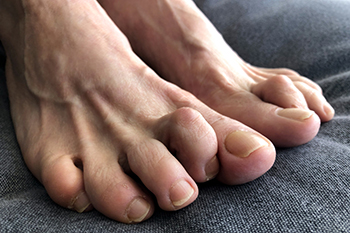
Drexel Hill (484) 521-0233
West Chester (610) 436-5883

Drexel Hill (484) 521-0233
West Chester (610) 436-5883

Hammertoe is a deformity that affects the toes, causing them to bend downward at the middle joint, resembling a hammer. It typically occurs in the second, third, or fourth toes and can be caused by a variety of factors. One of the primary causes is wearing tight or ill-fitting shoes that force the toes into unnatural positions. Other contributing factors include muscle imbalances, injury, and certain medical conditions like arthritis. There are two main types of hammertoe, flexible and rigid. In flexible hammertoe, the toe can still be moved, whereas in rigid hammertoe, the joint becomes fixed in a bent position. The symptoms of hammertoe include pain or discomfort when wearing shoes, visible bending of the toe, calluses or corns on the top of the toe, and difficulty walking. If you have developed a hammertoe, it is suggested that you consult a podiatrist who can offer effective relief options, helping you to manage this condition.
Hammertoes can be a painful condition to live with. For more information, contact the podiatrists of Dr. Siegerman & Associates. Our doctors will answer any of your foot- and ankle-related questions.
Hammertoe
Hammertoe is a foot deformity that occurs due to an imbalance in the muscles, tendons, or ligaments that normally hold the toe straight. It can be caused by the type of shoes you wear, your foot structure, trauma, and certain disease processes.
Symptoms
Risk Factors
Treatment
If you have hammertoe, you should change into a more comfortable shoe that provides enough room for your toes. Exercises such as picking up marbles may strengthen and stretch your toe muscles. Nevertheless, it is important to seek assistance from a podiatrist in order to determine the severity of your hammertoe and see which treatment option will work best for you.
If you have any questions, please feel free to contact one of our offices located in Drexel Hill and West Chester, PA . We offer the newest diagnostic and treatment technologies for all your foot care needs.
Request a free copy of
Laser Away Foot Pain!
today.
